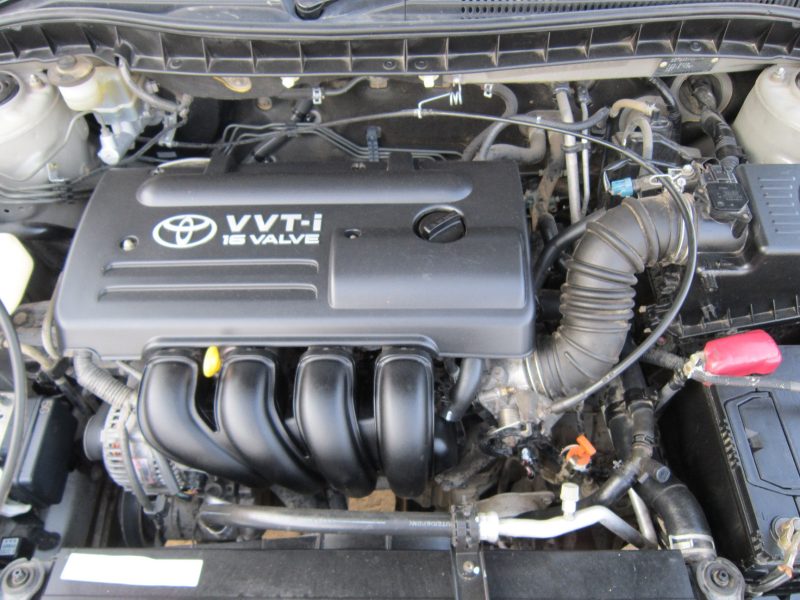Toyota 1ZZ engine characteristics
| Manufacture | Tianjin Toyota FAW Engine Plant No. 1 Toyota Motor Manufacturing West Virginia Shimoyama Plant |
| Engine make | Toyota 1ZZ |
| Years of manufacture | 1998-2007 |
| Cylinder block material | aluminum |
| Power system | injector |
| Type | row |
| Number of cylinders | 4 |
| Valves per cylinder | 4 |
| Piston stroke, mm | 91,5 |
| Cylinder diameter, mm | 79 |
| Compression ratio | 10 |
| Engine displacement, cc | 1794 |
| Engine power, hp/rpm | 120/5600 140/6400 143/6400 |
| Torque, Nm/rpm | 165/4400 171/4200 171/4200 |
| Fuel | 92 |
| Environmental Standards | Euro 4 |
| Engine weight, kg | 135 |
| Fuel consumption, l/100 km (for Celica) – city – highway – mixed. |
10.3 6.2 7.7 |
| Oil consumption, gr./1000 km | up to 1000 |
| Motor oil | 5W-30 10W-30 |
| How much oil is in the engine | 3.7 |
| Whether the oil has been changed, km | 10000 (better 5000) |
| Engine operating temperature, deg. | ~95 |
| Engine service life, thousand kilometers – according to factory data – in practice |
n.d. ~200 |
| Setting – potential – without loss of resource |
250+ n.d. |
| Installed engine | Toyota Corolla Toyota Avensis Toyota Caldina Toyota Vista Toyota Premio Toyota Celica Toyota Matrix XR Toyota Allion Toyota MR2 Toyota Opa Toyota Isis Toyota Wish Lotus Elise Toyota WiLL VS Chevrolet Prizm Pontiac Vibe |
Troubleshooting and repairing the 1ZZ-FE engine
The ZZ engine series was introduced in 1998 to replace the outdated but popular A-family engines. The first and most popular motor was the 1ZZ, which replaced the 7A. Among the innovations noted the use of lightweight aluminum cylinder block with cast iron liners, the replacement of the timing belt with a chain, the introduction of VVTi system to change the timing, the use of forged connecting rods and lightweight valves. The long piston stroke made the engine lower, which has its pros and cons. However, since the motors were aimed at the North American market, the main emphasis was on torque.

Unlike the previous A-family engines, the ZZ-series engines did not receive such a variety of modifications, although some variants did exist.
Toyota 1ZZ engine variants
- 1ZZ-FE is the basic and most common engine, and was produced at the Toyota Motor Manufacturing West Virginia plant. Power output ranges from 120 to 140 hp. Production from 1998 through 2007.
- 1ZZ-FED – similar to the 1ZZ-FE, produced at the Shimoyama plant, differed by the use of lightweight forged connecting rods, power 140 hp
- 1ZZ-FBE – a modification of the 1ZZ-FE engine, adapted for operation on biofuel and produced for the Brazilian market.
Troubles and faults of the 1ZZ engine and their causes
- Excessive oil consumption. This problem is characteristic of engines up to 2002 and is associated with wear of oil rings. It is solved by replacing the rings on later models (after 2005) and regular refilling of oil to the level of 4.2 liters. After that the problem usually disappears. Accumulation of carbon deposits and other measures will not help.
- Knocking in the engine 1ZZ, noise. Most often the cause lies in the wear of the timing chain, which can occur after a mileage of 150 thousand kilometers. The solution to the problem is to replace the chain. If the chain is in order, you should check the tensioner of the drive belt. The 1ZZ valves knock rarely, and adjustment is usually not necessary.
- Instable RPMs. Flushing the throttle assembly and idle valve solves this problem.
- Vibration in the 1ZZ engine. The rear engine cushion needs to be checked. If everything is fine and the engine is good, this is a feature of this engine.
In addition to the above problems, 1ZZ is sensitive to overheating, which can lead to deformation of the cylinder block and its replacement. According to official data, 1ZZ repair is not provided, and despite unofficial repair methods, such as liner or boring, the engine life remains low, about 200 thousand kilometers. As a result, many users consider the ZZ series to be problematic. However, if your engine was released after 2005, operated carefully and regularly serviced, there is no reason to worry – such a motor can last a long time.
Later, other engines were developed on the basis of 1ZZ, including sporty 2ZZ-GE, 1.6-liter 3ZZ-FE and 1.4-liter 4ZZ-FE. In 2007, the more advanced 2ZR-FE engine was introduced, replacing the 1ZZ-FE.
Toyota 1ZZ-FE engine tuning
Chip tuning. Atmo
When it comes to improving 1ZZ performance without turbocharging and other supercharging systems, there aren’t many options, but there are still a few tricks. Installing a cold intake, using Monkey Wrench Racing Stage 2 camshafts with 272 phase and 10mm lift, and a straight-through exhaust with a 4-2-1 manifold will all add up to 30hp and give the motor a more aggressive feel. Further modifications may not be necessary.
Turbo on 1ZZ-FE
Installing a Garrett GT28-based turbo kit with a set of manifold, midpipe, downpipe, intercooler, and blooff, as well as replacing the 440cc injectors, Walbro 255 pump, and Apexi Power FC control system with 0.5 bar pressure will achieve 200 hp on standard pistons. Increasing power would require lowering compression ratios by installing forged connecting rods and 8.5 compression pistons, swapping injectors to 550cc / 630cc, and porting the cylinder head, increasing the exhaust port to 2.5 inches and increasing boost to 300+ hp, but at the risk of breakage.
Compressor on a 1ZZ-FE
Installing a Toyota SC14 compressor with intercooler, blockoff, cold intake, 440cc injectors, Walbro 255lph pump, and Greddy E-manage Ultimate tuning will achieve around 200hp on standard pistons.
ENGINE SPECIFICATIONS: 4-
